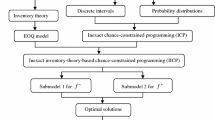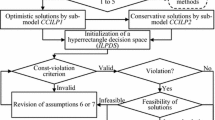Abstract
In this study, a random-boundary-interval linear programming (RBILP) method is developed and applied to the planning of municipal solid waste (MSW) management under dual uncertainties. In the RBILP model, uncertain inputs presented as interval numbers can be directly communicated into the optimization process; besides, intervals with uncertain lower and upper bounds can be handled through introducing the concept of random boundary interval. Consequently, robustness of the optimization process can be enhanced. To handle uncertainties with such complex presentations, an integrated chance-constrained programming and interval-parameter linear programming approach (ICCP) is proposed. ICCP can help analyze the reliability of satisfying (or risk of violating) system constraints under uncertainty. The applicability of the proposed RBILP and ICCP approach is validated through a case study of MSW management. Violations for capacity constraints are allowed under a range of significant levels. Interval solutions associated with different risk levels of constraint violation are obtained. They can be used for generating decision alternatives and thus helping waste managers to identify desired policies under various environmental, economic, and system-reliability constraints.



Similar content being viewed by others
References
Chang NB, Wang SF (1997) A fuzzy goal programming approach for the optimal planning of metropolitan solid waste management systems. J Oper Res 32:303–321
Charnes A, Cooper WW (1959) Chance-constrained programming. Manag Sci 6:73–79
Charnes A, Cooper WW, Kirby P (1972) Chance constrained programming: an extension of statistical method. In: Optimizing methods in statistics, Academic Press, New York, pp 391–402
Chi GF, Huang GH (1998) Long-term planning of integrated solid waste management system under uncertainty. University of Regina Report submitted to the City of Regina, Saskatchewan
Ellis JH (1991) Stochastic programs for identifying critical structural collapse mechanisms. Appl Math Model 15:367–379
Huang GH (1998) A hybrid inexact-stochastic water management model. Eur J Oper Res 107:137–158
Huang GH, Chang NB (2003) The perspectives of environmental informatics and systems analysis. J Environ Inform 1:1–6
Huang GH, Baetz BW, Patry GG (1992) An interval linear programming approach for municipal solid waste management planning under uncertainty. Civil Eng Syst 9:319–335
Huang GH, Baetz BW, Patry GG (1993) A grey fuzzy linear programming approach for municipal solid waste management planning under uncertainty. Civil Eng Syst 10:123–146
Huang GH, Baetz BW, Patry GG (1994a) Grey dynamic programming (GDP) for solid waste management planning under uncertainty. J Urban Plan Dev (ASCE) 120:132–156
Huang GH, Baetz BW, Patry GG (1994b) Grey chance-constrained programming: application to regional solid waste management planning. In: Hipel KW, Fang L (eds) Effective environmental management for sustainable development. Kluwer Academic Publishers, Dordrecht, pp 267–280
Huang GH, Baetz BW, Patry GG (1995a) Grey integer programming: an application to waste management planning under uncertainty. Eur J Oper Res 83:594–620
Huang GH, Baetz BW, Patry GG (1995b) Grey fuzzy integer programming: an application to regional waste management planning under uncertainty. Socioecon Plann Sci 29:17–38
Huang GH, Sae-Lim N, Liu L et al (2001) An interval-parameter fuzzy-stochastic programming approach for municipal solid waste management and planning. Environ Model Assess 6:271–283
Huang YF, Baetz BW, Huang GH et al (2002) Violation analysis for solid waste management systems: an interval fuzzy programming approach. J Environ Manage 65:431–446
Guo P, Huang GH, He L (2007) ISMISIP: an inexact stochastic mixed integer linear semi-infinite programming approach for solid waste management and planning under uncertainty. Stoch Environ Res Risk Assess. doi: 10.1007/s00477-007-0185-3.
Infanger G (1993) Monte Carlo (importance) sampling within a Benders decomposition algorithm for stochastic linear programs. Ann Oper Res 39:69–81
Infanger G, Morton DP (1996) Cut sharing for multistage stochastic linear programs with interstage dependency. Math Program 75:241–251
Inuiguchi M, Ichihashi H, Tanaka H (1990) Fuzzy programming: a survey of recent developments. In: Slowinski R, Teghem J (eds) Stochastic versus fuzzy approaches to multiobjective mathematical programming under uncertainty. Kluwer Academic Publishers, Dordrechts, pp 45–70
Johnson N, Kotz S, Balakrishnan N (1994) Continuous univariate distributions, vol 1. Wiley, New York
Kim JH, Mays LW (1992) Rehabilitation and replacement of water distribution system components considering uncertainties. Stoch Environ Res Risk Assess 4(4):277–294
Kursad A, Hadi G (2007) A chance-constrained approach to stochastic line balancing problem. Eur J Oper Res 180:1098–1115
Lee YW, Bogardi I, Stansbury J (1991) Fuzzy decision making in dredged-material management. J Environ Eng ASCE 117(2):614–628
Li YP, Huang GH (2006) Minimax regret analysis for municipal solid waste management: An interval-stochastic programming approach. J Air Waste Manag Assoc 56:931–944
Li YP, Huang GH, Nie SL, Nie XH, Maqsood I (2006) An interval-parameter two-stage stochastic integer programming model for environmental systems planning under uncertainty. Eng Optim 38(4):461–483
Li YP, Huang GH, Nie SL et al (2007) ITCLP: an inexact two-stage chance-constrained program for planning waste management systems. Resour Conserv Recycl 49:284–307
Luo B, Zhou DC (2007) Planning hydroelectric resources with recourse-based multistage interval-stochastic programming. Stoch Environ Res Risk Assess. Available on http://www.springerlink.com/content/103283
Maqsood I, Huang GH (2003) A two-stage interval-stochastic programming model for waste management under uncertainty. J Air Waste Manag Assoc 53:540–552
Maqsood I, Huang GH, Huang YF, Chen B (2005) ITOM: an interval-parameter two-stage optimization mode for stochastic planning of water resources systems. Stoch Environ Res Risk Assess 19(2):125–133
Morris HD, Mark JS (2001) Special distributions: the normal distribution. In: Probability and statistics, 3rd edn. Addison-Wesley Publishers, pp 194–205
Nie XH, Huang GH, Li YP et al (2007) IFRP: a hybrid interval-parameter fuzzy robust programming approach for waste management planning under uncertainty. J Environ Manag 84:1–11
Roubcns M, Teghem J (1991) Comparison of methodologies for fuzzy and stochastic multi-objective programming. Fuzzy Sets Syst 42:119–132
Tchobanoglous G, Theisen H, Vigil S (1993) Integrated solid waste management. McGraw-Hill, New York
Watanabe T, Ellis JH (1994) A joint chance-constrained programming model with row dependence. Eur J Oper Res 77:325–343
Yeomans JS, Huang GH (2003) An evolutionary grey, hop, skip, and jump approach: generating alternative policies for the expansion of waste management. J Environ Inform 1:37–51
Yeomans JS, Huang GH, Yoogalingam R (2003) Combining simulation with evolutionary algorithms for optimal planning under uncertainty: an application to municipal solid waste management planning in the Reginonal Municipality of Hamilton-Wentworth. J Environ Inform 2:11–30
Zare Y, Daneshmand A (1995) A linear approximation method for solving a special class of the chance constrained programming problem. Eur J Oper Res 80:213–225
Zeng Y, Trauth KM (2005) Internet-based fuzzy multicriteria decision support system for planning integrated solid waste management. J Environ Inform 6:1–15
Acknowledgments
This research was supported by the Major State Basic Research Development Program of MOST (2005CB724200 and 2006CB403307) and the Natural Science and Engineering Research Council of Canada. The authors are grateful to the editor and the anonymous reviewers for their insightful comments and suggestions.
Author information
Authors and Affiliations
Corresponding author
Appendix: Definitions regarding interval numbers
Appendix: Definitions regarding interval numbers
Definition A1
Let x denotes a closed set of real numbers. An interval number x ± is defined as an interval with known upper and lower bounds but unknown distribution information for x. That is x ± = [x −, x +] = {t∈x|x − ≤ t ≤ x +}, where x − and x + are the lower and upper bounds of x ±, respectively. When x − = x +, x ± becomes a deterministic number.
Definition A2
For x ±, the following relationships holds: x ± ≥ 0, iff x − ≥ 0 and x +≥0; x ± ≤ 0, iff x − ≤ 0 and x +≤0.
Definition A3
For x ± and y ±, the order relations are as follows: x ± ≥ y ±, iff x − ≥ y − and x + ≥ y +; x ± = y ±, iff x − = y − and x + = y +; x ± > y ±, iff x ± ≥ y ± and x ± ≠ y ±.
Definition A4
For x ±, Sign(x ± ) is defined as \( {\text{Sign}}(x^{ \pm } ) = \left\{ {\begin{array}{*{20}c} 1 & {{\text{if}}\,x^{ + } \ge 0} \\ { - 1} & {{\text{if}}\,x^{ + }\,<\,0} \\ \end{array} } \right.. \)
Definition A5
For x ±, its absolute value |x|± is defined as \( \left| x \right|^{ \pm } = \left\{ {\begin{array}{*{20}c} {x^{ \pm } } & {{\text{if}}\,x^{ \pm } \ge 0} \\ { - x^{ \pm } } & {{\text{if}}\,x^{ \pm }\,<\,0} \\ \end{array} } \right.. \) Thus, we have \( \left| x \right|^{ - } = \left\{ {\begin{array}{*{20}c} {x^{ - } } & {{\text{if}}\,x^{ \pm } \ge 0} \\ { - x^{ + } } & {{\text{if}}\,x^{ \pm }\,<\,0} \\ \end{array} } \right. \) and \( \left| x \right|^{ + } = \left\{ {\begin{array}{*{20}c} {x^{ + } } & {{\text{if}}\,x^{ \pm } \ge 0} \\ { - x^{ - } } & {{\text{if}}\,x^{ \pm }\,<\,0} \\ \end{array} } \right.. \)
Definition A6
Let R ± denote a set of interval numbers. An interval vector X ± is a tupel of interval numbers, and an interval matrix Y ± is a matrix whose elements are interval numbers: X ± = {x i ± = x − i , x + i ] | for any i} ∈ {R ±}1 × n, Y ± = {y ± ij = [y − ij , y + ij ] | for any i, j} ∈ {R ±}m×n.
Definition A7
In this paper, for interval vectors or matrices: X ± ≥/≤ 0 iff x ± ij ≥/≤ 0 for any i and j, where X ± ∈ {R ±}m × n(m ≥ 1, and m = integer).
Definition A8
Let * ∈ {+ , −, × , ÷} be a binary operation on interval numbers. For x ± and y ±: x ± * y ± = [min (x * y), max (x * y)], x − ≤ x ≤ x +, y − ≤ y ≤ y +. In the case of division, it is assumed that y ± does not contain zero. Hence x ± + y ±= [ x − + y −, x + + y +]; x ± − y ± = [ x − − y +, x + − y −]; x ± × y ± = [min (x × y), max (x × y)], x − ≤ x ≤ x +, y − ≤ y ≤ y +; x ± ÷ y ± = [min (x÷y), max (x÷y)], x − ≤ x ≤ x +, y − ≤ y ≤ y +.
Rights and permissions
About this article
Cite this article
Cheng, G.H., Huang, G.H., Li, Y.P. et al. Planning of municipal solid waste management systems under dual uncertainties: a hybrid interval stochastic programming approach. Stoch Environ Res Risk Assess 23, 707–720 (2009). https://doi.org/10.1007/s00477-008-0251-5
Published:
Issue Date:
DOI: https://doi.org/10.1007/s00477-008-0251-5




